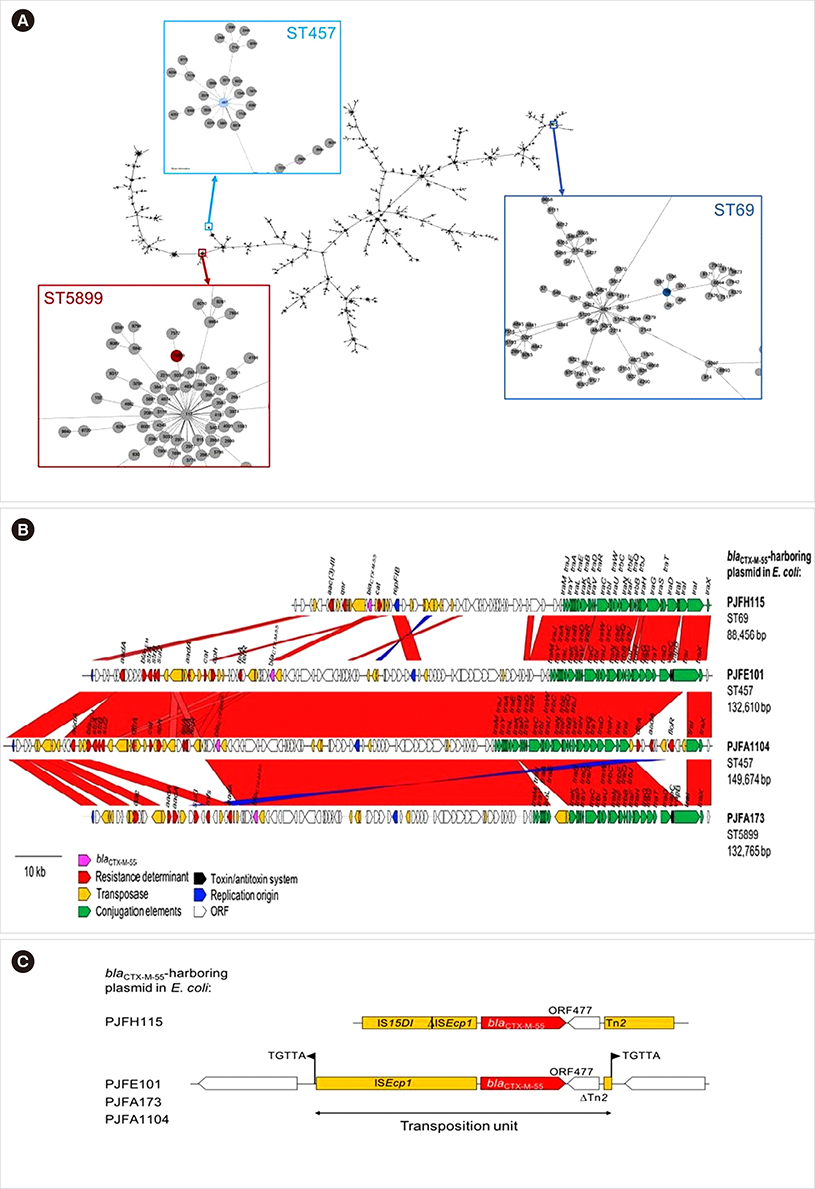Ann Lab Med.
2020 Mar;40(2):180-183. 10.3343/alm.2020.40.2.180.
Whole-Genome Analysis of bla(CTX-M-55)-Carrying Escherichia coli Among Pigs, Farm Environment, and Farm Workers
- Affiliations
-
- 1Department of Laboratory Medicine, National Health Insurance Service Ilsan Hospital, Goyang, Korea.
- 2Department of Laboratory Medicine, National Police Hospital, Seoul, Korea.
- 3Research Institute of Bacterial Resistance, Yonsei University College of Medicine, Seoul, Korea. leekcp@yuhs.ac
- 4Department of Laboratory Medicine, Yonsei University College of Medicine, Seoul, Korea.
- KMID: 2460918
- DOI: http://doi.org/10.3343/alm.2020.40.2.180
Abstract
- No abstract available.
Figure
Reference
-
1. Lee Y, Kim YA, Song W, Lee H, Lee HS, Jang SJ, et al. Recent trends in antimicrobial resistance in intensive care units in Korea. Korean J Nosocomial Infect Control. 2014; 19:29–36.
Article2. Andersson DI, Hughes D. Microbiological effects of sublethal levels of antibiotics. Nat Rev Microbiol. 2014; 12:465–478.
Article3. Powell N, Davidson I, Yelling P, Collinson A, Pollard A, Johnson L, et al. Developing a local antimicrobial resistance action plan: the Cornwall One Health Antimicrobial Resistance Group. J Antimicrob Chemother. 2017; 72:2661–2665.
Article4. Wirth T, Falush D, Lan R, Colles F, Mensa P, Wieler LH, et al. Sex and virulence in Escherichia coli: an evolutionary perspective. Mol Microbiol. 2006; 60:1136–1151.5. PlasmidFinder 2.0. Updated on Jun 2019. https://cge.cbs.dtu.dk/services/PlasmidFinder.6. ResFinder data sets. Updated on Jun 2019. https://cge.cbs.dtu.dk/services/data.php.7. Dorado-García A, Smid JH, van Pelt W, Bonten MJM, Fluit AC, van den Bunt G, et al. Molecular relatedness of ESBL/AmpC-producing Escherichia coli from humans, animals, food and the environment: a pooled analysis. J Antimicrob Chemother. 2018; 73:339–347.8. Levy SB, FitzGerald GB, Macone AB. Changes in intestinal flora of farm personnel after introduction of a tetracycline-supplemented feed on a farm. N Engl J Med. 1976; 295:583–588.
Article9. Endtz HP, Ruijs GJ, Klingeren B, Jansen WH, Reyden T, Mouton RP. Quinolone resistance in Campylobacter isolated from man and poultry following the introduction of fluoroquinolones in veterinary medicine. J Antimicrob Chemother. 1991; 27:199–208.
- Full Text Links
- Actions
-
Cited
- CITED
-
- Close
- Share
- Similar articles
-
- Diversity of Genetic Environment of bla(CTX-M) Genes and Antimicrobial Susceptibility in Extended-spectrum β-lactamase producing Escherichia coli Isolated in Korea
- Molecular characteristics of ESBLproducing Escherichia coli isolated from chickens with colibacillosis
- Comparisons of CTX-M-Producing Escherichia coli Isolates from Humans and Animals in South Korea
- Prevalence and Molecular Epidemiology of ExtendedSpectrum-β-Lactamase (ESBL)-Producing Escherichia coli From Multiple Sectors of the Swine Industry in Korea: A Korean Nationwide Monitoring Program for a One Health Approach to Combat Antimicrobial Resistance
- Comparison of Antimicrobial Resistance in
Escherichia coli Strains Isolated From Healthy Poultry and Swine Farm Workers Using Antibiotics in Korea


